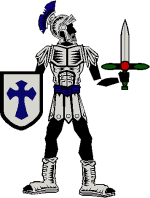
"For the word of God is quick, and powerful, and sharper than any two-edged sword, piercing even to the dividing asunder of soul and spirit, and of the joints and marrow, and is a discerner of the thoughts and intents of the heart."
~Hebrews 4:12~
Annie's "Armor
of God"
Page
![]()

"For
the word of God is quick, and powerful, and sharper than any
two-edged sword, piercing even to the dividing asunder of soul
and spirit, and of the joints and marrow, and is a discerner of
the thoughts and intents of the heart."
~Hebrews 4:12~
What is the ARMOR of God?

Armour is mentioned many times in the Bible. The word "Armour" in the King James language is the same word that we in the United States spell "Armor". The dictionary says that ARMOR is: "covering to protect the body made of metal". In
the Bible in the book of Ephesians it tells Believers to: |
| Ephesians 6:10-18 - The Armor of God |
| 6:10 | Finally, my brethren, be strong in the Lord, and in the power of his might. |
| 6:11 | Put on the whole armour of God, that ye may be able to stand against the wiles of the devil. |
| 6:12 | For we wrestle not against flesh and blood, but against principalities, against powers, against the rulers of the darkness of this world, against spiritual wickedness in high places. |
| 6:13 | Wherefore take unto you the whole armour of God, that ye may be able to withstand in the evil day, and having done all, to stand. |
| 6:14 | Stand therefore, having your loins girt about with truth, and having on the breastplate of righteousness; |
| 6:15 | And your feet shod with the preparation of the gospel of peace; |
| 6:16 | Above all, taking the shield of faith, wherewith ye shall be able to quench all the fiery darts of the wicked. |
| 6:17 | And take the helmet of salvation, and the sword of the Spirit, which is the word of God: |
| 6:18 | Praying always with all prayer and supplication in the Spirit, and watching thereunto with all perseverance and supplication for all saints; |
Let's
look at the parts of our ARMOR so we will know what we need to
wear:

Parts of the Armor of God: |
What it signifies: |
| Helmet
A defensive head-gear worn by soldiers - 1 Samuel 17:5,38; 2 Chronicles 26:14; Jeremiah 46:4 & Ezekiel 23:24 Figurative - Isaiah 59:17; Ephesians 6:17 & 1 Thessalonians 5:8 |
Helmet of salvation |
| Sword
The equipment of a soldier - Jeremiah 46:3,4 & Ephesians 6:14-17 Figurative - Romans 13:12; 2 Corinthians 6:7; 10:4; Ephesians 6:11-17 & 1 Thessalonians 5:8 |
Sword
of the Spirit - which is the Word of God
|
| Breastplate
Armor for soldiers - Revelation 9:9,17 Figurative - Isaiah 59:17; Ephesians 6:14 & 1 Thessalonians 5:8 Worn by
Aaron |
Breastplate of Righteousness |
| Feet shod | with the preparation of the gospel of peace |
| Shield - Defensive armor
- Different kinds of, designated as buckler, shield,
target - Psalms 35:2 & Ezekiel 38:4
Figurative
- |
Shield of faith |
| Armor
Nave's Topical Bible says this about ARMOR:
|
~Put
on the Armor of God
|
Loins ~Some information from Nave's Topical Bible~ Girdle of Truth - Ephesians 6:14 Wrestle
against---- |
-to be girt with truth
|

We as Christian believers are all suppose to be soldiers. We are
in the Lord's army. Do you know the "game plan"? Do you
have all the equipment that you need?
When you are in a WAR you have an "enemy" and expect a "battle".
All of this "equipment" for the Lord's Army is also the same items worn by the Priests of the Temple of the Lord. Interesting!!! We also read in the Old Testament that the Lord tells us that He is our shield and our reward. Use the links below to do a more detailed study on the Armor of God.
Here are some related pages from
concordances:
Baker’s Evangelical
Dictionary
page about "Armor"
Torrey’s Topical
Textbook
page about Arms, military
Nave’s Topical Bible page about the Girdle
Torrey’s Topical
Textbook
page about the Warfare of Saints
Torrey’s Topical
Textbook
page about the Breastplate
Torrey’s Topical
Textbook
page about the Girdles
Nave’s Topical Bible page about the Helmet
Torrey’s Topical
Textbook
page about Righteousness
Torrey’s Topical
Textbook
page about the Shields
Easton’s Bible
Dictionary
page about Shield
Torrey’s Topical
Textbook
page about the Sword
Easton’s Bible
Dictionary
page about War
|

Links for Spiritual Warfare:
Spiritual Warfare Ministries
Victorious in spiritual
warfare
Cheer Up, He has overcome
Freedom In Christ Ministry
Armor
of God Links:
Whose Armor Do You Wear?
Visit the Armor Room at Peggie's Place
Armour
Of God from MSSS Bible Lessons
NEW - Armor of God Coloring Pages & Armor of God Paper Craft
NEW - Danielle's Place - Armor of
God Crafts & Activities
Related
Pages by Annie:
Annie's Veteran's Day Page
Annie's Remembrance Day
Page
- Canadian Holiday
Annie's
Featured Holiday Page |
Annie's
Featured Page |
Copyright
2000 - 2010 Annie's Home Page. All Rights Reserved.
I thank the Lord for graphics artists without them these pages
would not be the same.
Please visit Annie's List of Great Graphics Spots for a list of their links.
Resources: The
World Book Encyclopedia; Ask
Jeeves;
Encyclopedia.com; GoTo; Infoplease;
Merriam-Webster; Roget's Thesaurus. This site hosted by: Christian Web Host.
Silent
No Right Click Script from Dynamic Drive. For Instructions on how
to add the no
right click script visit: Annie's "How to Add Silent No
Right Click Script" Page.
Castle Graphic came from Viki Mouse!